Welcome to our blog post titled “Animals You’ll See Flying and Crawling Around Alcatraz.” We’ll be exploring the diverse range of animal species that inhabit this historic island, from soaring seabirds to scurrying rodents. This article will provide an insightful glimpse into the natural world of Alcatraz and its inhabitants, offering a unique perspective on this iconic location. So sit back, relax, and let’s embark on a journey through the fascinating fauna of Alcatraz!
About Alcatraz
Alcatraz is a rocky island located in the San Francisco Bay, about 1.25 miles offshore from the city of San Francisco, California. It measures approximately 22 acres and has an elevation of about 120 feet above sea level at its highest point. The island is known for being home to the infamous Alcatraz Federal Penitentiary, which was operational from 1934 to 1963 and housed some of America’s most notorious criminals.
Today, Alcatraz Island serves as a popular tourist destination and historic site managed by the National Park Service. Visitors can take guided tours that provide insight into the island’s history as both a military fortification and maximum-security prison.
In addition to its rich human history, Alcatraz also boasts a diverse array of wildlife species that call it home. From seabirds like Western Gulls and Black-crowned Night Herons to land mammals such as black-tailed deer and raccoons, there are plenty of creatures to observe on this unique island ecosystem.
Whether you’re interested in learning about American criminal justice or just want to appreciate nature’s beauty up close, Alcatraz Island offers something for everyone who visits!
13 Animals Around Alcatraz Island
Alcatraz Island is home to many shore birds, sea birds, and only one mammal. We will take a look at all of them below.
Deer Mice — The Only Mammal on Alcatraz Island
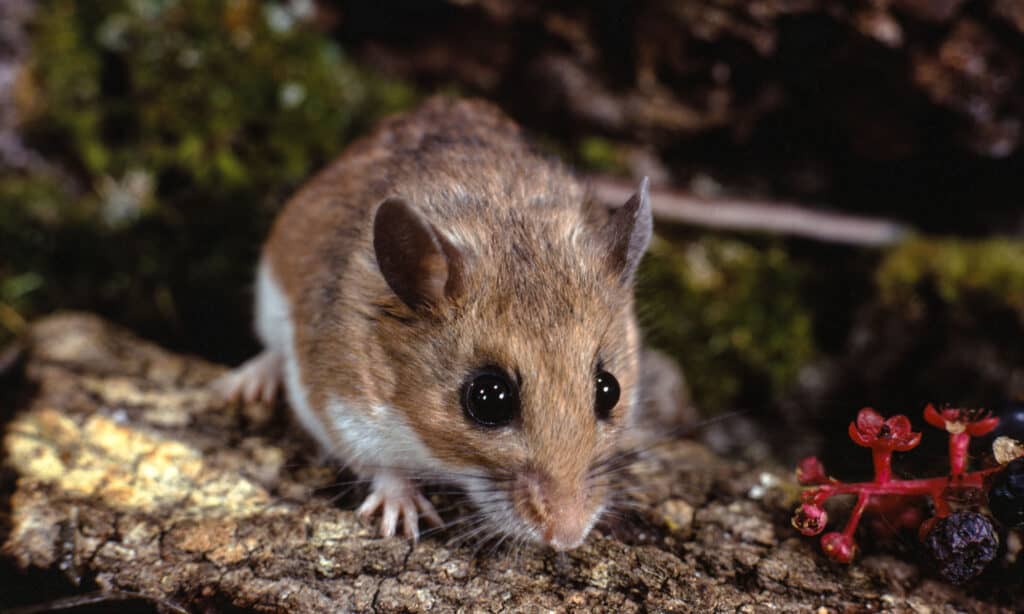
Deer mice (Peromyscus) can are the only mammal on Alcatraz.
©iStock.com/Weber
A deer mouse is a small, nocturnal rodent that can be found throughout North America. They are known for their large, dark eyes and long, bi-colored tails, which are typically longer than their bodies. Deer mice get their name from the reddish-brown coloring on their backs that resembles a deer’s coat. These creatures can often be seen darting around at night in search of food and shelter.
On Alcatraz Island specifically, deer mice have made themselves at home among the abandoned buildings and tunnels that once housed prisoners. Visitors may catch glimpses of these furry critters scurrying along the walls or even nesting inside old prison cells during nocturnal tours of the island. Deer mice are the only known mammal on Alcatraz Island!
Banana Slug

Named for its resemblance to a banana, the banana slug is found in humid areas where they aren’t in danger of drying out.
©Meyta/Shutterstock.com
A banana slug is a large, terrestrial mollusk that can be found in the wild areas surrounding Alcatraz Island. These creatures are known for their bright yellow color and distinctive shape, which includes a slimy body and two pairs of tentacles on their heads.
Banana slugs are primarily herbivores and feed on leaves, mosses, mushrooms, and other plant material. They prefer moist environments such as forest floors or damp meadows to live in. In addition to being hermaphroditic (meaning they have both male and female reproductive organs), banana slugs also play an important role in the ecosystem by breaking down decaying organic matter into nutrients that can be used by other organisms.
While they may not seem very exciting at first glance, banana slugs actually have some fascinating behaviors worth noting. For example, when threatened or disturbed by predators like birds or mammals, these slugs will often produce sticky mucus that makes them difficult to grasp or swallow whole. Additionally, during mating season, banana slugs engage in what is known as “penis fencing,” where each slug tries to inseminate the other using special spikes located on their bodies.
Overall, while perhaps not the most glamorous creature one might encounter around Alcatraz Island – there’s no denying that banana slugs are nonetheless interesting animals with unique adaptations and behaviors worth learning about!
Slender Salamander

Slender salalmanders live on Alcatraz Island.
©United States Geographical Survey / public domain – License
Slender salamanders are small, slender-bodied amphibians that belong to the genus Batrachoseps. They typically measure around 3-5 inches in length and have a distinctive elongated body shape with short legs. These creatures can be found throughout California, from the coast to the mountains, including at Alcatraz.
In terms of their diet, slender salamanders primarily feed on small insects such as ants, beetles, and termites. They are also known to consume spiders and other arthropods when available.
As for habitat, these salamanders tend to prefer moist environments such as forests or woodlands, where they can hide under rocks or logs during the day. They are most commonly found in areas with ample vegetation cover and access to water sources such as streams or ponds.
In terms of behavior, slender salamanders are generally nocturnal animals that spend much of their time hiding underground during daylight hours. When threatened or disturbed by predators or human activity, they will often curl up into a ball and secrete toxic substances from their skin as a defense mechanism.
White-Crowned Sparrow
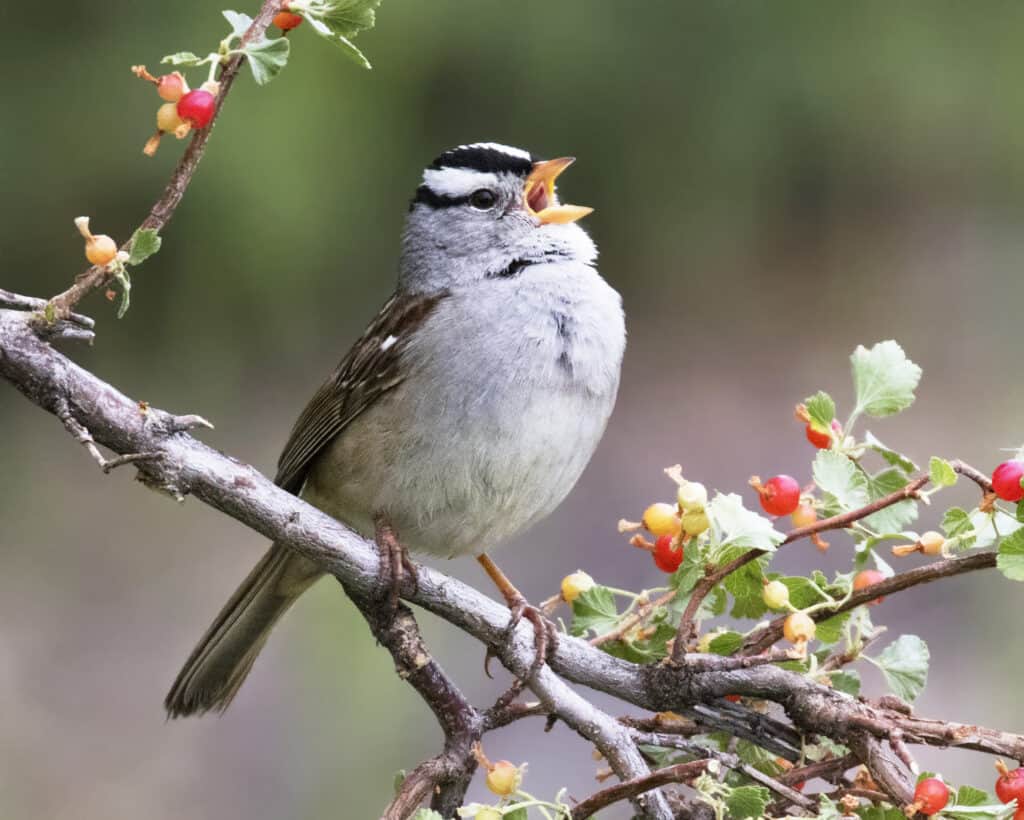
The white-crowned sparrow (Zonotrichia leucophrys) is a medium-sized New World sparrow native to North America.
©Rbrown10/Shutterstock.com
The white-crowned sparrow is a small songbird that belongs to the Passerellidae family. They are easily recognizable by their distinctive black and white striped head, with bright white stripes on either side of their crown. These birds have a wingspan of about 7 inches and weigh around one ounce.
White-crowned sparrows primarily feed on seeds, insects, and fruit. Their diet changes depending on the season. During winter months, they rely more heavily on seed consumption, while in summer, they incorporate more insects into their diet. The sparrows typically forage on or near the ground in open areas such as fields, grasslands, parks, or gardens.
In terms of habitat, these birds can be found throughout North America, from Alaska down to Central Mexico year-round. During the breeding season (from March through August), they inhabit brushy habitats or forests with dense understory vegetation, where they build nests made from twigs and bark strips.
One interesting behavior exhibited by these birds is their ability to sing complex songs consisting of multiple notes and phrases, which vary between individuals. Males use these songs to attract females during mating season and also communicate with other males who may be territorial rivals.
Anna’s Hummingbird

Annas hummingbirds are known for their vibrant colors.
©iStock.com/Jedlovec
Anna’s hummingbird is a small bird species that is commonly found in western parts of North America, including Alcatraz. These birds are known for their vibrant colors and swift movements, making them a popular sight for many birdwatchers.
In terms of diet, Anna’s hummingbirds primarily feed on nectar from various flowering plants such as sagebrush and manzanita. They also consume insects to supplement their protein intake. Due to the high energy demand required for their rapid wing flapping, they need to consume up to three times their body weight in food each day.
The habitat of Anna’s hummingbird varies depending on the season. During the breeding season (late winter through early summer), they can be found in coastal areas with plenty of flowers and other vegetation for nesting purposes. In the non-breeding season (fall through early winter), these birds tend to move inland towards warmer regions where there is still an abundance of food available.
As far as behavior goes, Anna’s hummingbirds are highly territorial creatures who will fiercely defend their feeding grounds against any perceived threats or intruders – even those much larger than themselves! Males often perform elaborate aerial displays to attract mates during the breeding season, while females build intricate nests out of spider webs and plant fibers.
Song Sparrow
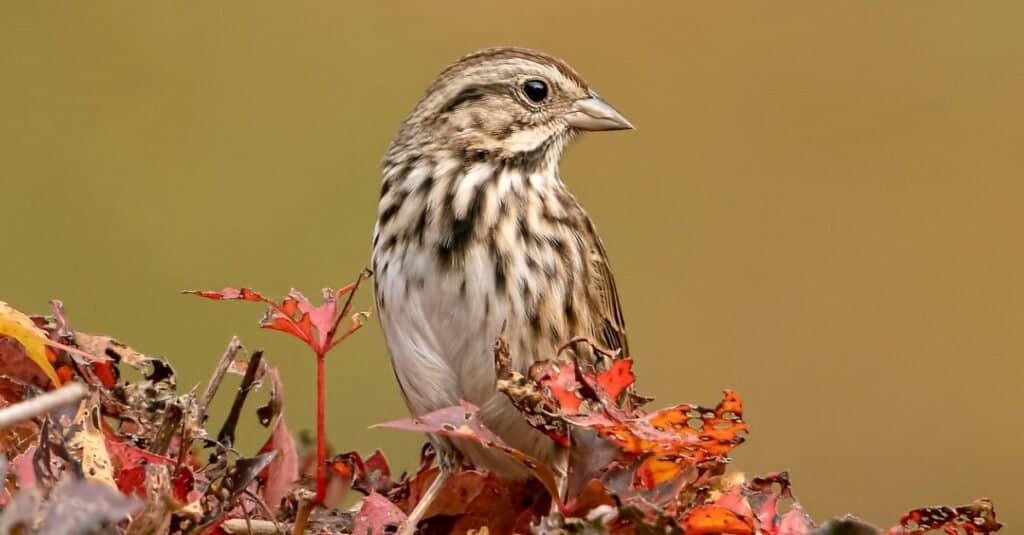
Song sparrows are one of the many birds on Alcatraz Island.
©iStock.com/Luc Pouliot
The song sparrow is a small bird species that belongs to the family Passerellidae. These birds are commonly found in North America, particularly in grasslands, shrublands, and forests. They have a distinctive brown streaked plumage with a white underbelly and a rust-colored cap on their head. The are one of the animals commonly found hanging around Alcatraz Island.
Song sparrows primarily feed on insects during the breeding season but switch to seeds and fruits during winter months when insects are scarce. Their diet may also include spiders, snails, and other small invertebrates.
In terms of habitat preference, song sparrows tend to occupy areas with dense vegetation, such as thickets or brushy edges near water sources like streams or ponds. They also adapt well to human-altered environments such as gardens or parks.
One interesting behavior exhibited by song sparrows is their territorial singing which serves as both an advertisement for mating partners and a warning signal for intruders. Males typically sing from high perches, while females build nests low in vegetation close to the ground.
Overall, these charming little birds play an important role in maintaining healthy ecosystems by controlling insect populations through predation while adding vibrant songs to our natural soundscapes.
Black Phoebe

Black Phoebe birds mainly eat insects that they catch in the air.
©iStock.com/G Parekh
The black phoebe is a small songbird that belongs to the flycatcher family. They are commonly found in western North America, including around Alcatraz Island. Their diet consists mainly of insects such as flies, bees, and wasps which they catch by swooping down from perches or mid-air. Black phoebes prefer habitats near water, such as streams, rivers, and ponds, because it provides them with an ample supply of their preferred food source.
These birds have a unique behavior where they constantly wag their tails up and down while perched. This tail-wagging motion helps them maintain balance on slippery surfaces like rocks near water sources, where they often hunt for food.
Black phoebes are known for being territorial and will defend their nesting sites aggressively against other bird species that may try to take over the territory. They build cup-shaped nests made of mud mixed with grass or moss that are typically placed underneath overhangs or ledges near water sources.
Overall, the black phoebe is a fascinating little bird whose unique behaviors make it an interesting sight to behold when visiting Alcatraz Island’s diverse wildlife population.
Common Raven
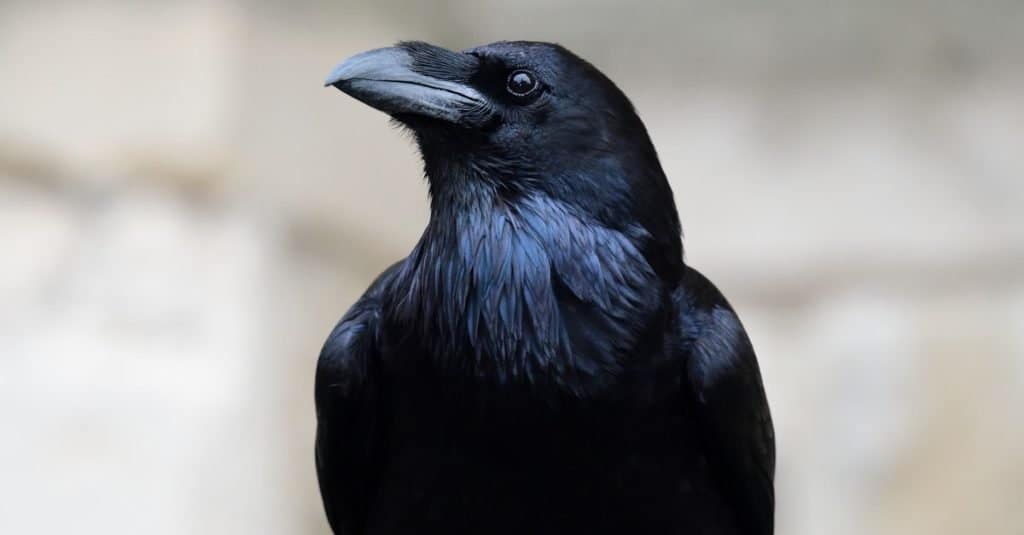
Common ravens are smart and curious birds.
©iStock.com/Tom Meaker
The common raven, also known as the northern raven, is a large black bird that belongs to the Corvid family. They are found across the Northern Hemisphere and can often be seen flying around Alcatraz Island.
Ravens are omnivores, which means they eat both plants and animals. Their diet includes insects, small mammals, birds’ eggs, carrion (dead animals), fruit, and nuts. They are opportunistic feeders and will scavenge for food wherever they can find it.
In terms of habitat, ravens prefer open areas such as tundra or desert regions but can adapt to urban environments like Alcatraz Island, where there is ample food available. They build their nests high up on cliffs or in trees using sticks and other materials.
Ravens have complex social behaviors and communicate with each other through various calls, including croaks, caws, clicks, and whistles. They mate for life and work together to raise their young. Overall the Common Raven is an intelligent bird that has adapted well to its environment, making it a fascinating species to observe on Alcatraz Island.
Snowy Egret
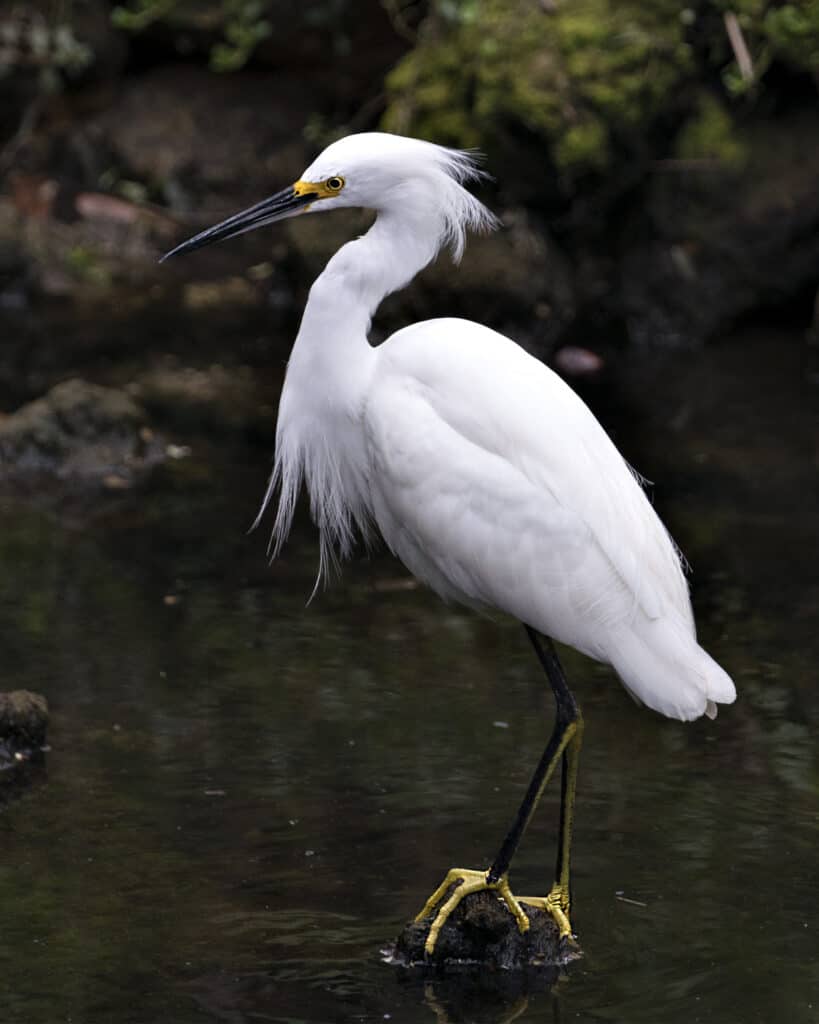
The snowy egret visits Alcatraz in warm weather.
©iStock.com/Rejean Bedard
The snowy egret is a medium-sized bird found in wetlands and coastal areas throughout North and South America. They are one of the most recognizable birds due to their brilliant white feathers, black legs, bright yellow feet, and distinctive long plumes on their back during the breeding season.
In terms of diet, snowy egrets primarily feed on small fish such as minnows or killifish but will also eat insects, crustaceans, and amphibians when available. Their hunting behavior is quite unique. They use their bright yellow feet to stir up prey from shallow waters before striking with their sharp beaks.
Snowy egrets prefer to nest in trees or shrubs near waterways where they can easily access food sources. During mating season (typically March through May), males will perform an elaborate courtship display that involves fluffing out their feathers and dancing around the female while offering her twigs or other nesting materials.
Unfortunately, snowy egret populations have declined significantly due to habitat loss caused by human development and pollution. Conservation efforts have been put in place to protect these beautiful birds so future generations can continue to enjoy them both in the wild and at places like Alcatraz Island.
Night Heron

Night herons have a wingspan of 45 to 47 inches.
©Wirestock Creators/Shutterstock.com
The night heron is a medium-sized bird that can be found in various parts of the world, including North and South America, Europe, Africa, and Asia. There are several different species of night herons, but they all share some general characteristics. They are one of the most beautiful animals to see flying around Alcatraz Island.
In terms of diet, the night heron primarily feeds on fish and other small aquatic animals, such as crabs and insects. They tend to hunt for food at dusk or during the night when their prey is most active.
As far as habitat goes, these birds can be found near bodies of water such as ponds, lakes, or streams, where they are able to find an abundance of food sources. Some species prefer marshy areas, while others may nest in trees near bodies of water.
When it comes to behavior patterns, night herons are generally solitary creatures except during breeding season when they form pairs. Their flight pattern is slow with deep wing beats which makes them easy to spot even from afar. Despite being called “night” herons because they frequently hunt during night-time hours, some species also forage during daytime hours too.
Black Oystercatcher

Black oystercatchers nest and lay eggs on Alcatraz Island.
©Wildpix 645/Shutterstock.com
The black oystercatcher is a unique and striking bird that can often be seen flying or crawling around the rocky shores of Alcatraz Island. These birds are easily recognizable by their distinctive all-black feathers, bright orange bill, and long pink legs.
Black oystercatchers are primarily found along the Pacific coast from Alaska to California. They live in areas with rocky shorelines or intertidal zones where they feed on a variety of prey, including mussels, clams, limpets, and other small invertebrates.
These birds are monogamous and form strong pair bonds during the breeding season, which typically occurs between March and July. Black oystercatchers will often reuse the same nesting location year after year to lay their eggs, which hatch after about 24 days.
Despite being relatively common along the West Coast, black oystercatchers face several threats, such as habitat loss due to coastal development and disturbances caused by human activity such as boating or recreational beach use. Conservation efforts have been put into place to protect these beautiful birds so future generations can enjoy them for years to come.
Cormorant — Breeding on Alcatraz Island

Several different types of cormorants visit Alcatraz Island.
©iStock.com/BrianLasenby
Cormorants are fascinating birds that can be found in various parts of the world, including around Alcatraz Island. These aquatic birds typically have dark feathers and a distinctive hooked bill, which they use to catch fish underwater.
In terms of their diet, cormorants primarily feed on fish, but they may also consume other small marine animals, such as crabs and squid. They are known for their impressive diving abilities, often submerging themselves for long periods of time (up to several minutes) while searching for prey.
As far as habitat is concerned, cormorants prefer coastal areas with rocky cliffs or islands where they can nest and roost safely away from predators. On Alcatraz Island specifically, these birds can be seen perched on the rocky outcroppings along the shoreline or flying overhead in search of food. They have made their breeding colonies on Alcatraz Island and regularly hatch chicks there.
One interesting behavior trait of cormorants is that they have been known to spread their wings out wide after diving into the water. This helps them dry off more quickly by exposing their feathers to sunlight and air currents.
Pigeon Guillemot
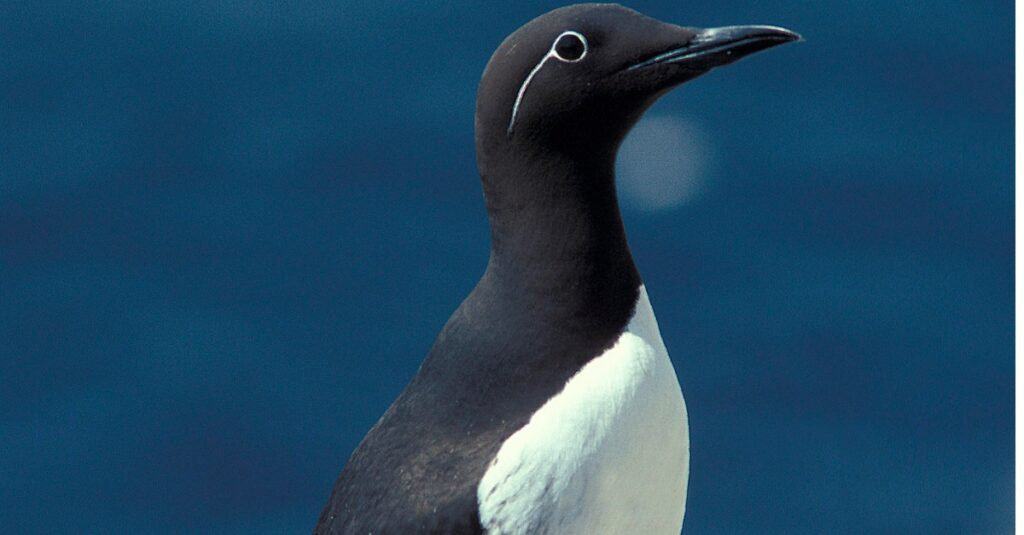
The pigeon guillemot is often confused with a penguin.
©iStock.com/slowmotiongli
The pigeon guillemot is a bird species that can be found in the waters surrounding Alcatraz Island. These birds are known for their distinctive appearance, which includes black feathers on their back and wings and white feathers on their underbelly. They also have bright red feet and a thin, pointed bill.
In terms of diet, pigeon guillemots primarily feed on small fish and invertebrates such as crustaceans and mollusks. They are known to dive underwater to catch these prey items, using their wings to swim through the water.
As for habitat, pigeon guillemots typically live along rocky coastlines or islands like Alcatraz. They nest in crevices or holes in rocks near the shoreline where they can easily access food sources.
In terms of behavior, pigeon guillemots are social creatures that often form pairs during the breeding season. During courtship displays, males will bring small fish to females as gifts. Pigeon guillemots communicate with one another through a variety of vocalizations, including whistles and trills.
Summary of the 13 Animals You May See Flying or Crawlin Around Alcatraz Island
Here are 13 Animals You May See Flying or Crawlin Around Alcatraz Island:
| Rank | Animals |
|---|---|
| 1 | Deer mice |
| 2 | Banana Slug |
| 3 | Slender Salamander |
| 4 | White-Crowned Sparrow |
| 5 | Anna’s Hummingbird |
| 6 | Song Sparrow |
| 7 | Black Phoebe |
| 8 | Common Raven |
| 9 | Snowy Egret |
| 10 | Night Heron |
| 11 | Black Oystercatcher |
| 12 | Cormorant |
| 13 | Pigeon Guillemot |
The photo featured at the top of this post is © D Ramey Logan, CC BY-SA 3.0 – License / Original
Thank you for reading! Have some feedback for us? Contact the AZ Animals editorial team.






